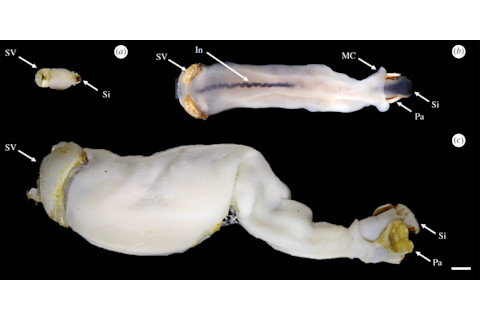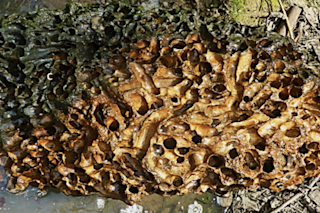What would a shipworm do if a shipworm didn’t eat wood? The humble bivalve has long had outsized influence on both its environment and even the global economy. That’s because, until now, every known species consumes wood, sometimes with destructive results.
A shipworm species new to science, however, tunnels through rock and eats it, too: It’s a story of an evolutionary oddity that’s as full of twists and turns as the burrows the animals leave behind.

The newly described species of shipworm, Lithoredo abatanica, bores through limestone in a freshwater environment thanks to a suite of unique adaptations. (Credit: Shipway et al 2019 Proc. R. Soc. B.)
Shipway et al 2019 Proc. R. Soc. B.
Shipworms are usually found in marine environments, where they burrow through wood, munching as they go, providing a big assist to the Circle of Life: breaking down the wood, from shallow driftwood to deep-water wood falls, provides other animals with nutrients, among other benefits.
Of course, if you’re a human sailing the high seas in a wooden ship, shipworms are not quite as welcome. First documented as the scourge of sailers some 2,500 years ago, the animals can wreak havoc not just on vessels but also fishing equipment, docks, piers and other structures.
Rock, Rock, Till You Drop
Lithoredo abatanica, the newly described shipworm, does things a bit differently. The bivalve lives in a freshwater environment along a short stretch of the Abatan River on Bohol Island in the Philippines.
There, the shipworm burrows into carbonate limestone, consuming the material as it travels. Like your average wood-eating shipworm, L. abatanica also secretes a chalky substance that forms what’s called a calcareous burrow lining. The researchers collecting the L. abatanica specimens found other animals, such as crabs and shrimp, setting up their homes in shipworm burrows that had been vacated.

Three L. abatanica specimens (I-III) are visible in this fragment of limestone. As the animals burrow into the rock, eating as they go, they create a chalky coating called a calcareous burrow lining (CBL). (Credit: Shipway et al 2019 Proc. R. Soc. B.)
Shipway et al 2019 Proc. R. Soc. B.
Specimens of L. abatanica ranged from less than an inch to more than 4 inches long. Perhaps not surprisingly, given its unique diet, the animal lacks the sharp, wood-chewing denticles of all its relatives and instead has broad, flat, spatula-like chompers. It’s missing several other adaptations for eating wood as well.
Other anatomical features, such as an exceptionally long intestine, are unique to the rock-eater. While it’s clearly a shipworm, L. abatanica‘s suite of peculiar adaptations, as well as its diet, make it highly unlikely to have evolved from the wood-eating branch of the family, say the researchers. Instead, it suggests a very early divergence into limestone-loving ways.
Totally Tubular Fossil Flummox
Finding the rock-eating shipworm raises a broader question. Because the calcareous burrow linings of shipworms often survive in the fossil record long after the wood around them is gone, these tube-like structures have been used by researchers as a proxy for the presence of woody material in an ancient environment.
L. abatanica throws that out the window, however. The authors point out that scientists can no longer assume the calcareous tubes were made by wood-eaters. The animals who left the linings behind might have just been rocking out.
The study appears today in the Proceedings of the Royal Society B: Biological Sciences.














